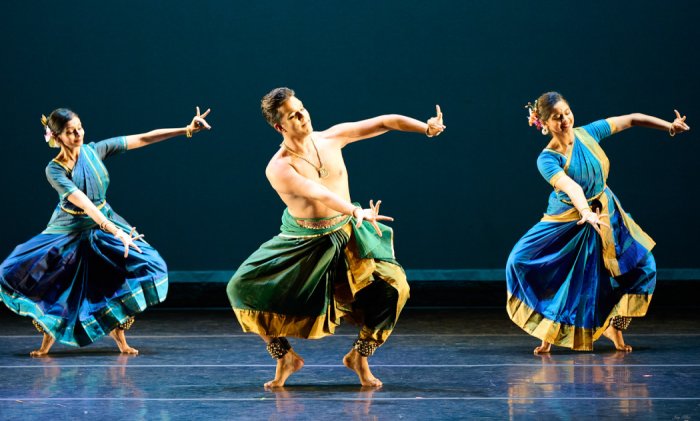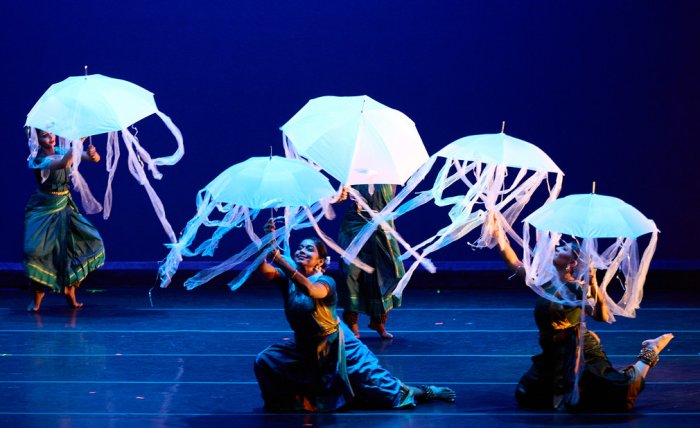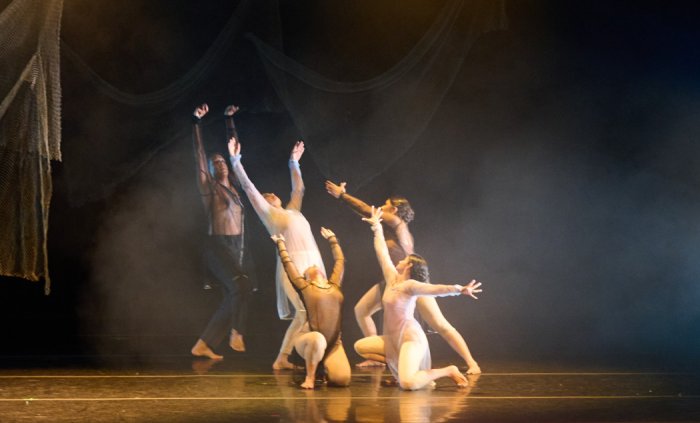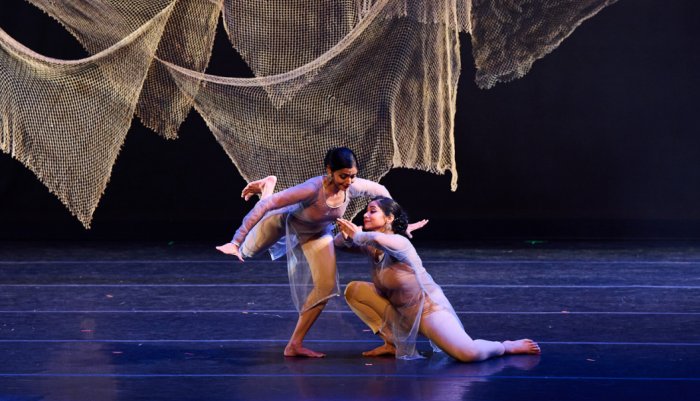
|   |

|   |
Through Fish Eyes - a renewed vision of new possibilities through the lens of Bharatanatyam - Aditya Venkataraman e-mail: aditya.venky@gmail.com Photos: Jay Pillai October 16, 2021 Among all the insidious difficulties of the pandemic, the depravation of the public to live art must be ranked highly. How the body needs oxygen, how the mind needs literature - the soul needs experiential art. Thankfully, Prakriti Dance provided a healthy dose of just that at the USF Theater on a sultry Saturday in Tampa, Florida. 'Through Fish Eyes' cannot be classified merely as a Bharatanatyam piece - though it has fast paced rhythmic sections drawn from the art form's toolkit. It cannot be classified as a Nature drama - though it has marvelous depictions of marine life. It cannot be classified as romantic yearning for the past - though it portrays the idyllic times of yore. At best, 'Through Fish Eyes' can be considered a Call to Arms. It is a devastating depiction of the present and an urgent beseeching to imagine new futures.  The balance between Man and Water has never been equal. And how can it be? Water existed long before Man and will remain long after life itself on Earth. The opening piece of the production brilliantly depicts the primeval nature of water - the rain, the rising tides, and the miracle of the Water Cycle. Accompanied by thumping music, the dancers enter the stage like forces of nature. Their speed and sharp movements jolted the audience awake from any Saturday lethargy and prepared them for what was to follow. The Early Man emanated from water, and repeatedly returned to it for his nourishment, adventure, and self-discovery. It was a relationship built on harmony and respect. The joyful pirouettes of the dancers captured through movement the forgotten smells of this halcyon time. The scene where the fisherman catches fish for the sustenance of his family, but releases anything extra was surprisingly effective to hammer this point of symbiotic harmony between man and nature. As Gandhi said, this world has enough for everyone's need but not enough for even one person's greed. Fitting that the production was being staged on Gandhi's birthday. The opening sections were frequently interspersed with traditional Bharatanatyam sections where the dancers showcased their strong foundations in the art form. This isn't a muddled dilettante fusion of the classical and the contemporary: this is a strategic interpretation of the contemporary through the classical.  Between these fast paced sections, the production takes a breather and offers snapshots of water and all the varieties of life in it. Which led us to the crowning piece of the production - the montage of corals and all the life forms that it sustains. The dancers came together to create a coral bed out of which sprung forth crabs, fish, and sea horses. The glacial movements of the dancers, accompanied to a moving, ethereal score transported the viewers to this underground wonder world. The physical proximity of the dancers at this point conveyed a sense of intimacy - the same intimacy enjoyed between the coral and its guests. The changes in temperature of the ambient lighting added to the experience of submerged delight. Even the currents-induced gentle swaying was in the grammar of Bharatanatyam - wah! The production then soared - literally - as the dancers took flight as cranes and herons flying over the waters and scooping into the waters and emerging with throbbing fishes in their beaks. Was this Bharatanatyam? How could it not be? So harmonious was the fusion of art and animal. The music changes now, for the ominous. Plastic is discovered. The Evil Man stirs the pot of greed and out comes the malleable bubbles of plastic, depicted viscerally by the dancers. Even the costumes change - the vibrant hues of the opening sequences are replaced by dull garbs of colorlessness. A striking reminder on how modernity is sucking out even the colors of life from the world around us and replacing it with the boring thrum of modern sameness. Plastic ushers in the age of mass production. The dancers fuse into a factory production line, demonstrating the pipelines of the modern age running with brutal Nazi-esque efficiency. How can the gracefulness of Bharatanatyam capture the utter lack of grace of modern industry? Somehow these dancers achieve it.  What follows are tragic vignettes of the clash between plastic and marine life. A carelessly disposed straw, introduced with theatric affect, kills a turtle. A depraved net mercilessly interrupts a game of catch between a whale and her calf, replacing joy with horror. The lament of the mother whale and the deconstruction of her psyche were some of the more abstract moments of the production. Alas, all is not doom, yet. The hand that destroys could yet be the hand that nourishes too. The last piece, a more joyful but forceful item ends with this call to arms. Man needs nature and not the other way around. 'Through Fish Eyes' boldly pushes the boundaries of Bharatanatyam. A living art form must engage with the most pressing challenges of its age: 'Through Fish Eyes' achieves this goal. It spoke to the audience in ways that a rehashing of beaten down topics just cannot. Even its musical choices were refreshing: from Sangam poetry, to traditional compositions, to English poetry, all set to soaring musical scores. The lighting, costumes, and accessories all came together in the central artistic mission. Throughout the work, one could discern the deliberate mind of an artist - and full credit for this must go its artistic director Kasi Aysola, and its musical director Ramya S Kapadia. Their bold visions were realized with crystalline clarity by the other dancers Archana Raja, Madhuvanti Sundararajan, and Madhvi Venkatesh. The choreography was crisp and minimal - its purpose not to subdue audiences with an acrobatic flourish, nor to dunk them in melodrama - it zigged when the message called for it, and zagged when artistic sensibilities demanded it.  Although one must concede that a few scenes left the audience puzzled – for instance, the scene showing the coming together of dolphins and whales in friendship left many in the audience scrambling for understanding. A visual cue, perhaps in the form of a background projection of the animals being depicted flowing behind the dancers, would have helped bridge some of these gaps. The voiceover in the same scene felt muted by the loud score and the snippets one heard weren't enough to piece together the meaning. I personally was also not a fan of the fist-thumping chants of Change at the very end. For a production that so far followed a very show, don't tell attitude, the chanting felt out-of-place. But these minor gripes fade in comparison to the achievements of the production. After bestowing the performers with thunderous applause and appreciation, the audience, among whom ranked many budding Bharatanatyam students, filed out of the auditorium with a renewed appreciation of the art form and a realization that it need not just be the voice for repackaged stories from mythologies, but it can also be the clarion call for change. Aditya Venkataraman is a Software Engineer based in the San Francisco Bay Area. He is an avid writer and art enthusiast. |